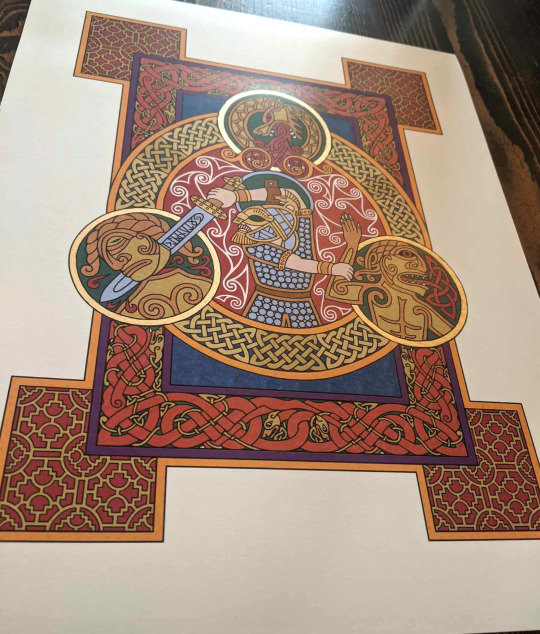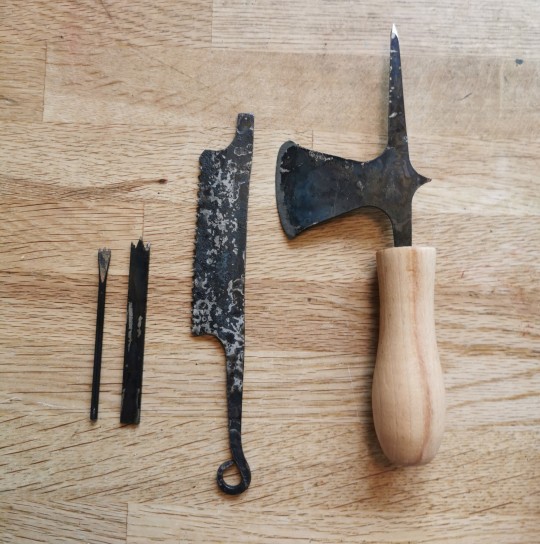#anglosaxon
Text


Beowulf: The Monster Cycle illumination is finished. This will be one of the full page illuminations in the Beowulf book, as well as available as an 11" x 14" print.
The project is launching in only a few days; sign up with the link below to get notified when we launch:
#illumination#calligraphy#leatherbound#celtic art#celtic#medieval#tolkien#norse#middle earth#knotwork#viking#beowulf#anglosaxon#english literature#books#book illustration
208 notes
·
View notes
Text
youtube
Discover the Anglo Saxon kings of England | DiscoverMiddleAges
8 notes
·
View notes
Text
I am calling the entire knightcore tag for being NORMAN PROPAGANDA and WEIRD BODYGUARD KINKS that don’t make a whole lot of sense in historical context. If you want SAXON AND NORSE PROPAGANDA, a very niche and less romanticized medieval warrior elite and the potential for even WEIRDER bodyguard kinks that make SLIGHTLY MORE SENSE in historical context, convert. Come to the dark side. We have cool rings and swords and helmets and stuff and have cozy warm halls where you can warm your hands by the fire and enjoy a cup of something nice and some weird Northern European food with your weird early medieval thegn buddies.
42 notes
·
View notes
Text

Sutton Hoo helmet
Anglo-Saxon
7th century
British Museum
London, June 2022
66 notes
·
View notes
Text

Spring has sprung here in the U.S. with signs of Germany's Easter traditions everywhere! I made a post yesterday on the history of Ēostre, Ēosturmonath, and Easter traditions in the U.S. Please go to my profile page and check them out if you're interested.
I love to find ways to incorporate my skills and talents into my spiritual practices. One of my biggest joys in life is COOKING! So it's no surprise that I use food and traditional recipes to connect with Germanic culture. Inspired by the season, I found this recipe to share with you!
Sächsischer Osterkuchen
12 servings
Ingredients
2 cups flour
9 Tbsp butter
1 packet vanilla sugar
6 Tbsp sugar
1 pinch salt
1 egg
For the quark filling:
2 cups quark (Magerquark, lean quark)
4 egg yolks
1 cup sugar
2 Tbsp brandy or rum
1 small pinch of saffron powder
1/2 cup ground almonds
1/2 cup currants
zest of 1 lemon
3 Tbsp butter, melted
4 oz whipping cream
In addition:
flour for rolling
1 egg yolk
powdered sugar for dusting
Preheat oven to 350°F/180°C
Directions
Dough: mix flour with butter, vanilla, sugar, salt, and one egg. Knead it into a dough. Cover the dough, allowing it to rest at room temperature or warm oven for 30 minutes.
Filling: drain the quark in a colander. Beat egg yolks with sugar, alcohol, butter, and saffron until the mixture is creamy and the sugar has dissolved. Stir in the almonds, followed by the currants, lemon zest, melted butter, and cream. Add the quark last.
Roll out 2/3 of the dough on a floured work surface. Place on the bottom of a greased springform pan (10" / 26 cm diameter). Use the remaining third of the dough to form the sides. Spread the quark mixture to the pan and smooth it out slightly. Bake for about 50 mins.
Mix egg yolk with a small amount of water. Remove cake from oven and drizzle the egg and water evenly over the surface of the cake. Return to oven and allow the cake to bake for another 10-15 mins. Remove the cake and let it rest in the pan on a wire rack for 20 mins. With a sharp knife, loosen the sides from the pan and remove the cake. Dust cake with powdered sugar and serve while still warm.
Recipe Credit: germanfoods.org
Image Credit: germanfoods.org
14 notes
·
View notes
Text

Bespelling the Æcerbót (Field Remedy) at the Ealdríce Théod's 2023 Solmónaþ faining at Whitthenge Heall in Richmond, Virginia.
#theodish#theodish belief#theodishbelief#theodism#ealdrice#heathenry#heathen#anglosaxonheathenry#anglosaxon
8 notes
·
View notes
Text

Runetober Day 14: Dried Flowers
(following the woodland magic prompts by smalltownspells)
More dried herbs than dried flowers, but close enough.
Today's illustration is the Nine Herbs Charm. I did a full illustration of it last year, which took so long, I had to stop inktober, but today I made a smaller one with only short text passages.
We have the nine herbs in a circle, with the Anglo-Saxon runes on the spears around them giving a short insight on how they are described in the original Nine Herbs Charm text:
Mugwort, Una, the oldest of herbs.
Waybread, mother of herbs.
Lambcress, the herb growing on a stone.
Nettle, the herb tha fought against the serpent.
Betony, the one that will fight.
Chamomile, prepared for food.
Chervil, the very mighty herb
Crab-apple, sent by a seal across the sea
Fennel shaped the lord when he hung.
Around it, written in the nine segments of a killed dragon/snake the runes read about the creation of the Charm:
A worm came creeping, he tore a man in two
then Woden took nine Glory-Twigs,
struck the adder then, that it flew apart into nine.
In the middle we have Woden, the depiction is inspired, albeit slightly changed, from a 8th century Anglosaxon Sceatta coin.
The Old English text:
Mucgwyrt Una, yldost wyrta
Wegbrade, wyrta modor
Stune, wyrt heo on stane geweox
Stiðe, wyrt seo wiþ wyrm gefeaht
Attorlaðe, seo læsse ða maran
Mægðe to mete gegyrede
Fille, felamightigu wyrta
Wergulu, onsænde seolh ofer sæ
Finule gesceop drihten hongode
Wyrm com snican, toslat he man;
ða genam Woden nigon wuldortanas,
sloh ða þa næddran, þæt heo on nigon tofleah.
In Anglo-Saxon runes:
ᛗᚢᚳᚷᚹᚣᚱᛏ·ᚢᚾᚪ·ᚣᛚᛞᚩᛋᛏ·ᚹᚣᚱᛏᚪ
ᚹᛖᚷᛒᚱᚪᛞᛖ·ᚹᚣᚱᛏᚪ·ᛗᚩᛞᚩᚱ
ᛥᚢᚾᛖ·ᚹᚣᚱᛏ·ᚻᛖᚩ·ᚩᚾ·ᛥᚪᚾᛖ·ᚷᛖᚹᛖᚩᛣᛋ
ᛥᛁᚦᛖ·ᚹᚣᚱᛏ·ᛋᛖᚩ·ᚹᛁᚦ·ᚹᚣᚱᛗ·ᚷᛖᚠᛠᚻᛏ
ᚪᛏᚩᚱᛚᚪᚦᛖ·ᛋᛖᚩ·ᛚᚨᛋᛖ·ᚦᚪ·ᛗᚪᚱᚪᚾ
ᛗᚨᚷᚦᛖ·ᛏᚩ·ᛗᛖᛏᛖ·ᚷᛖᚷᚣᚱᛖᛞᛖ
ᚠᛁᛚᛖ·ᚠᛖᛚᚪᛗᛁᚻᛏᛁᚷᚢ·ᚹᚣᚱᛏᚪ
ᚹᛖᚱᚷᚢᛚᚢ·ᚩᚾᛋᚨᚾᛞᛖ·ᛋᛖᚩᛚᚻ·ᚩᚠᛖᚱ·ᛋᚨ·
ᚠᛁᚾᚢᛚᛖ·ᚷᛖᛋᚳᛖᚩᛈ·ᛞᚱᛁᚻᛏᛖᚾ·ᚻᚩᛝᚩᛞᛖ
ᚹᚣᚱᛗ·ᛣᚩᛗ·ᛋᚾᛁᛣᚪᚾ·ᛏᚩᛋᛚᚨᛏ·ᚻᛖ·ᛗᚪᚾ:ᚦᚪ·ᚷᛖᚾᚪᛗ·ᚹᚩᛞᛖᚾ·ᚾᛁᚷᚩᚾ·ᚹᚢᛚᛞᚩᚱᛏᚪᚾᚪᛋ:ᛋᛚᚩᚻ·ᚦᚪ·ᚦᚪ·ᚾᚨᛞᚱᚪᚾ·ᚦᚨᛏ·ᚻᛖᚩ·ᚩᚾ·ᚾᛁᚷᚩᚾ·ᛏᚩᚠᛚᛠᚻ
#mine#runetober#runes#anglosaxon#old english#nine herbs charm#my art#smalltownspells#mugwort#plantain#lambcress#nettle#betony#chamomile#chervil#crab-apple#fennel#herbology#woden#odin
10 notes
·
View notes
Text


Not to reenactment post on main but!!! My tools i ordered from the blacksmith finally arrived!!!! AH
They are so sick, i will get so much use of em
#Personal#Reenactment#Viking#Anglosaxon#Medieval#Roman#Boneworking#Leatherworking#The bone saw works so so well
6 notes
·
View notes
Photo

@kiva.siani: "I am the #mixedchild of #mixedchildren of mixed children. We're #mixed in our biology & culture. My children are mixed too. My father's side is #IndigenousAmerican #AngloSaxon #BlackAmerican descended from slaves stolen from #SierraLeone & #GuineaBissau. Somewhere in his father's blood is #Basque, & his mother's #Indonesian but listed as negro for her dark skin. That side of the family is middle-class, & recent generations are from N. East of the U.S. My father moved to California in his early 20s. My mother & Grammy was born in LA. My Grammy is 41% #Irish, 16% #French, 34% is #WestAfrican, 5% #Congolese. The rest is traces of #Choctaw. I got a DNA break down for her. Her mother's family was from Oklahoma. My mom's dad was from South Carolina, his mom was #Cherokee & #Black descended from slaves. His father was full Irish. People generally think i belong to their people unless they're very light or very dark. Ive been pegged for Columbian. I get all the various South American & afro Caribbean, also Black & various Asian & the southeast Asians think I belong to them too. In Germany, tho cabinets get locked. In Uganda I couldnt get service outside the resort without help. I'm incredibly into where politics, culture & economics collide. Living in #ambiguous skin & with my upbringing is helpful in this. Im able to slip in on conversations that are often so revealing or that they never would say if they could tell I'm 'Black' I lean in my economic views. Which leads into my biggest problem as a mixed girl, other than my hair. It's the expectation of experience, tastes, methods of moving forward socially. Lately, I've been getting this litmus test as I've been stepping into a new social group of black folks. No other group does this to me, not even the ones I don't belong to." 🇺🇸🏳️🇸🇱🇬🇳🇮🇩🇮🇪🇫🇷🇨🇬🌍 *⠀⠀⠀⠀⠀⠀⠀⠀⠀ It's #BlackHistoryMonth! DM me about your experiences #beingmixed & Black for a feature! Check out my How To: Be Featured Story for a Shoutout! ☝️ Following me is required! Want to skip the line?? Follow & dm my personal page @donnisbutterfly & say hi! 💋 Join my Mixed Girl #SubscriptionSquad for $2.99 a month! https://www.instagram.com/p/CovXr5QOa5o/?igshid=NGJjMDIxMWI=
#mixedchild#mixedchildren#mixed#indigenousamerican#anglosaxon#blackamerican#sierraleone#guineabissau#basque#indonesian#irish#french#westafrican#congolese#choctaw#cherokee#black#ambiguous#blackhistorymonth#beingmixed#subscriptionsquad
4 notes
·
View notes
Photo

Handmade with love ❤️ #thoridsgewandschneiderei #gewandung #selfmade #peplos #history #historylover #historischekleidung #larpcostume #larp #handgenäht #reenactment #mittelalterkleidung #celtic #germanen #kelten #historylovers #dresshistory #etsy #etsyshop #anglosaxon #anglosaxonhistory #medievalhistory #earlymedieval #earlymedievalreenactment (hier: Petersberg, Rheinland-Pfalz, Germany) https://www.instagram.com/p/Cmo_TqmL0Lr/?igshid=NGJjMDIxMWI=
#thoridsgewandschneiderei#gewandung#selfmade#peplos#history#historylover#historischekleidung#larpcostume#larp#handgenäht#reenactment#mittelalterkleidung#celtic#germanen#kelten#historylovers#dresshistory#etsy#etsyshop#anglosaxon#anglosaxonhistory#medievalhistory#earlymedieval#earlymedievalreenactment
5 notes
·
View notes
Text
The Shieldmaiden's Honour - locations
The Shieldmaiden's Honour - locations
#ancientrome #roman #histfic #writing #britannia #frankia
Busy day today – finished proof-reading of the final manuscript of “The Shieldmaiden’s Honour“, and reached a one-third point in the first draft of Madron’s last story, “The Shieldmaiden’s Throne” – soon out for pre-order. It’s some two weeks until the “Honour’s” release, so it’s about Ttime for the traditional Locations post.
This time, Madron ventures into lands we haven’t seen yet in the Song…

View On WordPress
#ancient rome#anglosaxon#belgium#britannia#england#fens#france#frankia#frisia#geography#history#lincoln#lincolnshire#locations#maastricht#map#netherlands#nijmegen#publishing#shieldmaidens honour#shieldmaidens pride#song of britain#song of madron#writing
3 notes
·
View notes
Text

Hi friends,
I did a Kickstarter campaign a couple of years ago to fund the production of a hand-illuminated insular Gospel book. I'm planning a new campaign for early next year to do a similar illumination project for Beowulf, featuring the Old English and modern English translation on facing pages. I would love some input for reward tier ideas that people would be interested in receiving as part of the project. Some of the ones I have planned already will be a large illuminated art print, the regular hardcover book once it's finished and published, as well as a high-end hand bound leather version. What are some other Beowulf/Anglo-Saxon relevant rewards you would be interested to see?
Thank you!
#medieval#illumination#calligraphy#celtic art#norse#middle earth#leatherbound#kickstarter#rewards#beowulf#old english#anglosaxon
195 notes
·
View notes
Text
youtube
Discover the Anglo-Saxon Gods, my latest video.
If you enjoy it, please like it and subscribe to my channel, thanks.
5 notes
·
View notes
Text
Broke: “lord king”
-explicitly masculine
-sounds weird
-female equivalent is “lady queen” which I’m not sure was a thing people said(?)
Woke: ring-giver
-anybody can give you a ring
-rings are pretty
-sounds poetic and awesome
-thank you for the ring
49 notes
·
View notes
Text


Anglo-Saxon claw beaker
* Mucking
* early 400s
* British Museum
London, July 2022
47 notes
·
View notes
Text

Hello everyone!
Every year I see a lot of people get upset about Ēostre. I understand that. It’s frustrating when people claim something is ancient or well-documented when it is neither! It’s important to note, however, that Neo-Paganism itself is a far cry from the traditions of ancient Pagans. There is a balancing act at work here. While everyone is entitled to their own spiritual path, we must also be careful of spreading misinformation.
Ēostre’s only attestations are two authors; the highly disputed monk Bede and the famous folklorist Jacob Grimm. Neither provided concrete evidence for her, and Grimm’s only real contribution was calling Bede’s claims plausible. According to Bede, the Anglo-Saxons named the month of April Ēosturmonath, in recognition of a nearly forgotten Goddess called Ēostre.
For context, the Anglo-Saxons were members of Germanic tribes that settled in England between the 5th century and the Norman Conquest. While the word "Germanic" is just an umbrella term for the numerous cultures of Germanic-speaking peoples spread all over Northern, Central, and Western Europe.
In Anglo-Saxon Paganism, Ēostre is often associated with the light of dawn, new beginnings, growth, and youthfulness. In Neo-Paganism, her symbols are spring flowers, birds, eggs, and rabbits or hares (white ones especially). It’s important to note that neither Bede nor Grimm ever associated the Goddess Ēostre with eggs, rabbits/hares, or flowers! These modern-day attributions were born from our own attitudes toward the Spring season. As I’ve said in previous posts, I take no issue with UPG (Unverified Personal Gnosis) as long as we’re clear about what’s what!
Before we really dig in, I need to emphasize that we don’t know much of anything for certain about Pagans. These peoples had oral traditions, whether you’re talking about Celtic or Germanic traditions. They passed down their beliefs, history, mythology, and religion through orated poems, stories, and songs. Our written accounts are from conquering nations, political enemies, and Christian monks who lived long after these traditions were said to have died out. Bede, as I mentioned, is the sole source for Ēostre, and his work is met with criticism for many reasons. Nevertheless, Ēostre has still become synonymous with the Spring Equinox in Neo-Paganism.
THE LUNISOLAR CALENDAR
TACITUS’ GERMANIA
According to Tacitus, Germanic Pagans didn’t follow a Solar calendar like the impression the Wheel of the Year might give. In his book, Germania, he explains, ”They assemble, unless upon some sudden emergency, on stated days, either at the new or full moon, which they account the most auspicious season for beginning any enterprise. Nor do they, in their computation of time, reckon, like us, by the number of days, but of nights. In this way they arrange their business; in this way they fix their appointments; so that, with them, the night seems to lead the day.”
NORDBERG’S CALENDAR
Many Reconstructionists and Neo-Pagans are adopting a calendar outlined in a paper by Stockholm University Professor Andreas Nordberg. He writes, “The pre-Christian Yule feast occurs at the first full moon after the first new moon following the winter solstice…” Meaning that solar events are celebrated one lunar cycle after their occurrence. But it’s important to point out that even Nordberg’s calendar is hardly uniform. He continues to say, "...while the Disting took place at the third full moon according to the same method of calculation.”
If you were to apply Nordberg’s first technique to Ôstara, it would look like this:
March 20th 2023 ~ Spring Equinox
March 21st 2023~ New Moon
April 6th 2023~ Full Moon/Ôstara
A Germanic Lunisolar calendar would explain why Bede associated Ēostre with April rather than the Equinox in March. And that, collectively, is why I have started observing Ôstara roughly one lunar cycle after the Spring Equinox.
ANGLO-SAXON CALENDAR
The Venerable Bede was a Christian monk and scholar who lived in the 7th and 8th centuries. In his book, he begins his section on the English months by explaining that the English from the olden times, “calculated their months according to the course of the moon. Hence, after the manner of the Greeks and Romans, [the months] take their name from the Moon, for the Moon is called mona and the month monath.”
He goes on to describe these months and their names, “The first month which the Latins call January, is Guili; February is called Solmonath; March is Hrethmonath; April, Ēosturmonath; May, Thrimilchi; June, Litha; July, also Litha; August, Weodmonath; September, Halegmonath; October, Winterfylleth; November, Blodmonath; December, Guili, the same name by which January is called.”
Later, he finally describes his account of Ēostre, “Ēosturmonath has a name which is now translated ‘Paschal month,’ and which was once called after a goddess of theirs named Ēostre, in whose honour feasts were celebrated in that month. Now they designate that Paschal season by her name, called the joys of the new rite by the time-honoured name of the old observance.”
These quotes are the foundation upon which we’ve built up this mysterious figure Ēostre. I’m not saying that the Anglo-Saxons or other Germanic Pagans didn’t have spiritual traditions centered around Spring. Nature worship is the main criterion for Paganism, ancient or new. It is well-known that many Gods, Goddesses, and other spirits are personifications of different aspects of life or nature. Ancient Pagans saw magic everywhere, as we do now. No, the details and specifics Bede wrote are what is in question. As with any text, his work bears to be scrutinized and re-examined again and again.
GRIMM'S ÔSTARA THEORIES
The most commonly cited source after Bede is from the folklorist Jacob Grimm. In his book, Deutsche Mythologie, Grimm reflects on Bede's work, "...the Anglo-Saxon historian tells us the names of two beings, whom he expressly calls ancient goddesses of his people, but of whose existence not a trace is left amongst other Germans. A clear proof, that here as well as there, heathenism was crowded with divinities of various shape and varying name, but who in their characteristics and cultus corresponded to one another."
Later in the text, Grimm expands on his opinion of the Goddesses named by Bede, "It would be uncritical to saddle this father of the church, who everywhere keeps heathenism at a distance, and tells us less of it than he knows, with the invention of these goddesses. There is nothing improbable in them, nay the first of them is justified by clear traces in the vocabularies of other German tribes."
It would seem that Jacob Grimm’s opinion mirrors that of most Neo-Pagans today. Why would Bede, a Christian monk, invent a Goddess? Especially when a person considers the strange and ill-fitting combination of German Springtime traditions and the story of the Resurrection of Jesus. But Grimm offers no hard evidence to support Bede outside of a few etymological connections.
I can understand the critiques of Bede’s claims. Have you ever heard someone make up a fact to sound more intelligent, interesting, or worldly? I have. Ultimately, however, I believe that there is no harm done so long as we promote full disclosure regarding the origins of our Neo-Pagan traditions.
If you’re one of my longtime readers, you know that I respect the complexity of reconstructing Pagan faiths. Whether you look forward to Ôstara every year or think the whole thing’s bullshit, I respect your beliefs. For me, what’s important is that we recognize the history (or lack thereof) and the cultural impact of the holidays we celebrate.
U.S. EASTER TRADITIONS
Before I go, I’d like to give you some background regarding our Easter traditions in the United States. Where did they come from? When did they get here?
Well, historical records start with a German scientist named Johannes Richier. In 1682 his dissertation was published, which mentions the Easter Hare. He explains that in Germany, on Easter, colored eggs are hidden by a fictional being called “Osterhase” or the “Easter Hare.” These eggs are then found and quickly devoured–causing stomach aches, according to Richier’s report.
While I couldn’t find any specifics, it seems unanimously agreed that this German Easter custom came to the U.S. through the immigration of Pennsylvanian Dutch communities in the 1700s. It’s believed that sometime after that the Easter Hare was rebranded as the Easter Bunny we know today.
In the future, I’d like to cover the folk origin stories of this egg-laying hare. Let me know what you think in the comments~
Check out this article from Smithsonian Magazine for more Easter Bunny History:
https://www.smithsonianmag.com/history/the-ancient-origins-of-the-easter-bunny-180979915/
CHECK BACK TOMORROW FOR AN AUTHENTIC GERMAN EASTER RECIPE!
REFERENCES
Venerable Bede, The Reckoning of Time, trans. Faith Wallis (Liverpool University Press, 1999), pages 53-54
Jacob Grimm, Teutonic Mythology vol. 1, trans. James Steven Stallybrass (London: George Bell and Sons, 1882), pages 289, 291.
Cornelius Tacitus, Tacitus on Germany, trans. Thomas Gordon (Project Gutenberg eBooks) https://www.gutenberg.org/cache/epub/2995/pg2995-images.html#link2H_4_0002
Nordberg, Andreas. “Yule, Disting and Pre-Christian Time Reckoning”, Royal Gustav Adolf's Academy for Swedish Folk Culture, Uppsala, Sweden. https://www.academia.edu/1366945/Jul_disting_och_f%C3%B6rkyrklig_tider%C3%A4kning
“Where Did the Easter Bunny Come From? Ask This Dead German Scientist,” Live Science, March 30th, 2018, https://www.livescience.com/62184-easter-bunny-osterhase-origins-eggs.html
6 notes
·
View notes